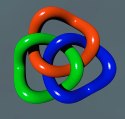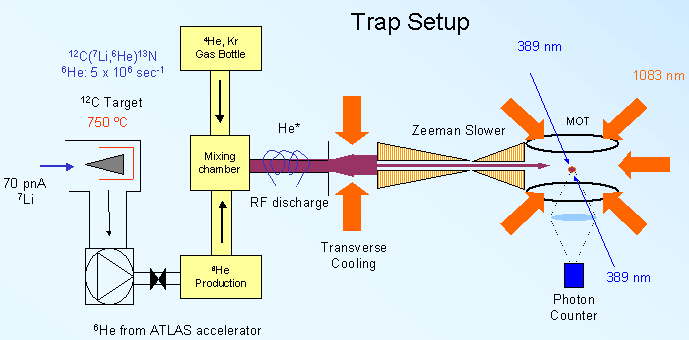Laser Spectroscopic Determination of the 6He Nuclear Charge Radius
L.-B. Wang,1,2 P. Mueller,1 K. Bailey,1 G.W.F. Drake,3 J. Greene,1 D. Henderson,1 R.J. Holt,1 R.V.F. Janssens,1 C.L. Jiang,1 Z.-T. Lu,1 T.P. O’Connor,1 R.C. Pardo,1 K.E. Rehm,1 J.P. Schiffer,1 X.D. Tang,1
1Physics Division, Argonne National Laboratory; 2University of Illinois at Urbana-Champaign; 3University of Windsor, Canada
Motivation
 |
The 6He (t1/2 = 807 ms) and 8He (t1/2 =119 ms) nuclei offer the unique opportunity to study interactions in low-density neutron-rich matter. The measurement of the charge radii of these isotopes will probe the interaction of the neutron halo with the 4He-like core and test the existing theoretical models that give precise predictions for the charge radii. |
Atomic Isotope ShiftBy measuring the isotope shift of atomic transitions, the difference in the charge radii of helium isotopes can be determined. The isotope shift depends on the change in nuclear mass (mass shift, ~ 40 GHz) and the difference in charge radius (field shift, ~1 MHz ). The mass shift can be calculated very precisely for this two electron system using modern atomic theory . The field shift is then extracted by subtracting the calculated mass shift from the measured isotope shift. The challenge lies in the high precision requirement for the isotope shift measurement (~ 100 kHz uncertainty in the isotope shift correlates to about 1% error on the charge radius of 6sup>He), the small available number of the short-lived 6He atoms at on-line facilities and the fact that in helium high resolution laser spectroscopy is only possible from the metastable 23S1 level. |
 |
Experimental Setup
| The production of 6He was carried out at the ATLAS accelerator at Argonne National Lab. The 6He isotope was produced by the 12C(7Li,6He)13N nuclear reaction, effused out of the graphite target, and was transferred and compressed into the discharge source to populate the metastable level. To perform the high resolution laser spectroscopy we took advantage of atom trap trace analysis (ATTA), which has been developed by our group for the trace detection of 81,85Kr. This method is based on trapping the desired isotope in a magneto optical trap (MOT), and detecting it by observing the fluorescence light. It has been demonstrated that ATTA is virtually background free and is capable of detecting single atoms. Additionally, the atom is inherently cooled while in the trap and the Doppler broadening is largely reduced. ATTA allowed us to perform the precision spectroscopy on single atoms. To avoid light shift, the trapping light at 1083 nm has to be turned turned off during each spectroscopy period. The spectroscopy laser at 389 nm is scanned over 18 MHz in 6 Microseconds, with a probing-recooling duty cycle of 1:4. A combination of two detuning frequency in the trapping light enables the efficient recooling while maintaining large loading efficiency. |
 |
Results and Outlook
Two experimental runs were performed in April and May of 2004. A precision of ~ 60 kHz in measuring the isotope shift between 4He and 6He was achieved, which results in a determination of 6He nuclear charge radius with an uncertainty of ~ 0.7%. This result is independent of nuclear models of the charge distribution and can now be compared to previous experiments as well as predictions from various nuclear theories.
What about 8He? While the identical laser spectroscopic setup can be used for the measurement of the 4He-8He isotope shift and extraction of its nuclear charge radius, the production cross section for this very neutron rich isotope is much smaller. In the near future we will try different target/beam combinations at ATLAS to investigate 8He production cross sections and to find the optimum combination. |
 |
||||||||
| This work is supported by the U.S. Department of Energy, Contract W-31-109-ENG-38. | |||||||||
References
Laser Spectroscopic Determination of the 6He Nuclear Charge Radius PRL Abstract / Preprint (nucl-ex/0408008)L.-B. Wang, P. Mueller, K. Bailey, G. W. F. Drake, J. P. Greene, D. Henderson, R. J. Holt, R. V. F. Janssens, C. L. Jiang, Z.-T. Lu, T. P. O’Connor, R. C. Pardo, K. E. Rehm, J. P. Schiffer, X. D. Tang
Physical Review Letters 93, 142501 (2004)
Fine Structure of the 1s3p 3PJ Level in Atomic 4He: Theory and Experiment PRL Abstract / Preprint (physics/0407114)
P. Mueller, L.-B. Wang, G. W. F. Drake, K. Bailey, Z.-T. Lu, and T. P. O'Connor
Physical Review Letters 94, 133001 (2005)
Towards measuring the charge radius of 6He and 8He
P. Mueller, L.-B. Wang, K. Bailey, G.W.F. Drake, X. Du, J. Greene, A.M. Heinz, R.J. Holt, D. Henderson, R.V. Janssens, C.-L. Jiang, C. Law, Z.-T. Lu, I.D. Moore, T.P. O'Connor, R.C. Pardo, M. Paul, T. Pennington, K.E. Rehm, J.P. Schiffer
Nuclear Instruments and Methods in Physical Research B204, 536 (2003)
![[Argonne Logo]](/images/argonne_header_logo.jpg)
![[DOE Logo]](/images/header_doe.gif)